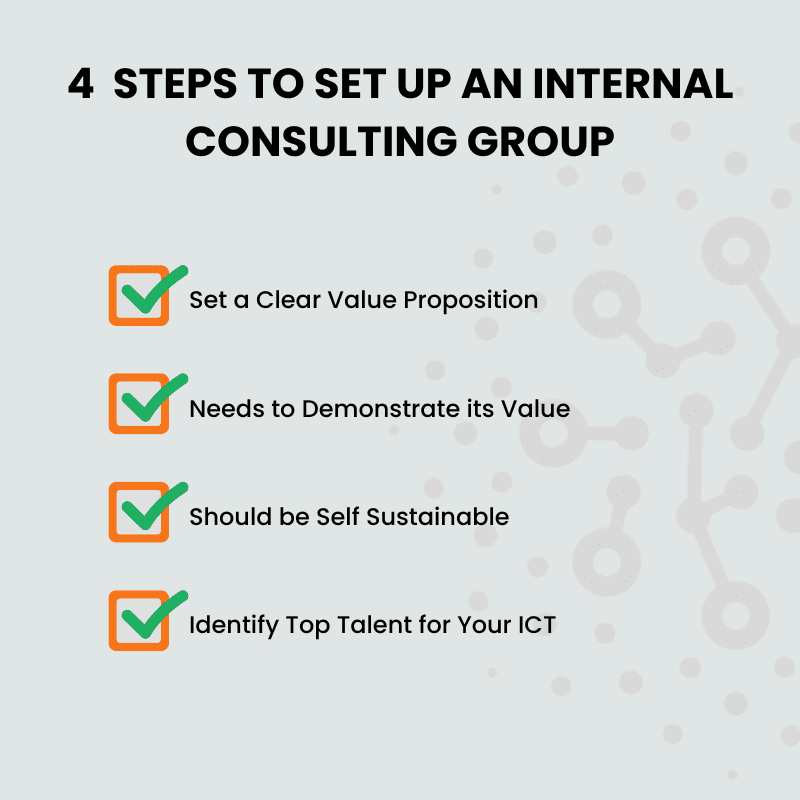In today’s competitive landscape, organizations are seeking innovative ways to optimize operations, minimize expenses, and drive strategic growth. One avenue that is garnering attention is the creation of Internal Consulting Groups. Whether referred to as centers of excellence or by any other name, this concept is more than a trend – it’s a strategy with tangible benefits.
With the constant pressure on operational expenses, many companies are recognizing the value of internalizing resources to meet recurring needs for consulting. It’s a logical step for those handling sensitive projects where privacy and trust are paramount. Moreover, the cost-efficiency of employing an in-house team as opposed to engaging external consultants cannot be understated.
However, venturing into the realm of internal consulting is not without challenges. Before you even consider setting up a group, a thorough understanding of your needs is crucial. A spend analysis, providing insights into volumes and price, can be a smart first step in building a compelling business case.
Once the decision is made, the real work begins. How do you create an internal consulting group that is not just functional but stellar? In the following sections, we’ll explore four easy steps to set up a best-in-class internal consulting group that aligns with your company’s unique goals and needs. These steps will guide you towards success in leveraging in-house expertise without compromising on quality and efficiency.
The Catalysts Behind the Surge of Internal Consulting
At a time when most large companies now have a corporate venturing entity, another trend has started to emerge in most Companies: internal consulting. While most Western companies regularly use Consulting, the hefty prices combined with the need for specialized resources has prompted some clients to explore new options to fulfil their needs.
Consulting expenses have also skyrocketed in the last 20 years. On the one hand, Companies are buying way more than before. On the other hand, the major players have steeply increased their fees per consultant. With the pressure on OPEX, executives have to find other ways to get expert support at a lower cost.
Not so long ago, working with consultants was a guarantee to discover new methods. However, today, with the commoditization of part of the management theories and tools, companies can directly access the knowledge, and hence hiring external consultants is no longer the only option open to businesses.
Indeed, Internal consultants can capture knowledge and expertise faster than more generalist consulting players because they work with only one client in one industry. And they make up for their lack of external benchmark through a stronger intimacy with the company, its business, and its culture.
Lastly, companies have become increasingly conscious of the importance of confidentiality. Many External Consultants have done a business of accumulating data about their clients and using the benchmark to serve their competitors. In some projects, working with internal teams can be the best way to keep secrets in the house.
Steps to Setting Up an Internal Consulting Group
There are already some recurrent consulting needs that are apparent when you consider your plan and the difficulties you will face in the next three to five years. Building internal consulting capacity can frequently get off to a solid start if there is a consistent, long-term, and clearly defined requirement for consulting services.
In any case, deciding to form an internal consulting group is just the first act. To ensure lasting results, a few factors must be present.

#1. Set A Clear Value Proposition
First and foremost, internal groups must have a distinct value proposition, much like external consultants.
The group’s primary area of expertise and concentration must be very apparent, even though you want them to remain flexible. The group should outline the places where their expertise will have the most significant influence and the areas where they have the slightest knowledge.
#2. Let Them Showcase Their Value to the Organization.
As Coach Rasheed Wallace would put it: “Ball don’t lie.” In other words, the group has to demonstrate its value to the rest of the organization. The group has to win projects thanks to a superior impact on the organization.
Internal Consulting Groups have been forced to be used by many businesses. If internal consulting teams can provide performance close to the external ones, the trade-off will almost always lean in favor of the internal team.
#3. Ensure That the Internal Consulting Group Is Self-Sustainable
The team needs to be able to support itself by billing the internal clients despite the prospect of a corporate financial boost. If the internal clients don’t see the benefit, the group won’t last for very long.
The self-sustainability of a consulting firm comes from three main sources: the fees they charge for their services, the sales of their products, and the reinvestment of their profits.
But for an internal consulting group, the scope will be much more limited. They often have only one client. Some may start to sell the services and products to other clients, but it remains rare. Besides, their profits would be drowned in the company’s overall profits and the decision of reinvestment made as part of the strategy cycle.
So the only way to be self-sustainable for an internal consulting group is to generate enough revenues to be break-even and enough value to be considered a center of profit and “deserve” investments.”
Businesses cannot afford to maintain internal consulting groups that can grow indefinitely. There are few chances for consultants to advance internally.
Hence, the team must come up with creative ways to make the already meagre cash they have available work for them to become self-sustaining.
The managers are to be more involved in the execution of projects. By cutting down operation costs to the minimum, Internal Consulting Groups provide value to the organization while performing self-sustainably.
#4. Identify the Top Talent for Your Internal Consulting Team
There is a talent war going on in the consulting profession. Finding and keeping the best talent in the internal consulting group can sometimes be challenging. The remuneration scale in the consulting sector is extraordinarily generous.
Industrial Companies find it difficult, if not impossible, to stay up. It may become impossible for a company to hire a senior consultant or a partner. They must be creative to draw in the proper personnel and provide them with growth chances.
Additionally, it might be challenging to land the following position inside a corporation once a consultant has accepted a position with a high-income package.
A route less traveled is to embed a few years in the internal consulting group as part of the career path for high-potential executives. GE is incubating Crotonville graduates as black belt project leaders before advancing their careers. This solution allows them to solve the compensation gap issue and increase the intimacy level with the company.
One of the most striking differences between top consulting firms and internal consulting groups is the homogeneity of talent. The talent pool in external consulting firms is exceptionally robust, sometimes at the expense of diversity. Nevertheless, we cannot deny the impact on the quality of talent available in most consulting firms.
An internal group will show more heterogeneous profiles. Blame critical mass and internal HR policy reasons. Besides, Global consulting firms can provide instant access to a worldwide talent pool when an internal consulting group is often centralized at the headquarter.
Lastly, the tenure of the consultants is usually not the same. Joining an internal consulting group is considered a step in an employee’s career. Companies cannot afford to have permanent internal consulting structures of unlimited size. The opportunities for consultants to develop from within are also limited.
Closing Thoughts
Internal Consulting is a growing trend today. Internal Consulting groups offer organizations plenty of advantages from increased privacy and trust when working on sensitive projects to the most significant one – cost-effective solutions and the opportunity to lower expenses compared to hiring External Consultants.
When you are running projects through your internal Consulting Group, it is essential to measure the impact of the projects and the satisfaction of your internal clients. Having feedback on their work is a fantastic tool for building improvement and development plans.
Your internal consulting group will be able to grow their skills on the right dimensions and serve better their internal clients. It is also a compelling way to convince internal clients to use their services while comparing them with similar external service providers.
When making a decision about your next project, it is worth evaluating all the elements and picking the team of consultants that is best suited for the project and who is prepared to deliver the best results.
internal consulting group internal consulting group internal consulting group internal consulting group
internal consulting group internal consulting group internal consulting group internal consulting group
internal consulting group internal consulting group internal consulting group internal consulting group

How Consource Can Help?
Consource is your ideal partner in sculpting a top-tier internal consulting group. From conducting an initial spend analysis to comparing ROI with external consultants, we equip you with the insights and tools needed to monitor progress and ensure success. Let Consource guide your internal group on the right track.








0 Comments